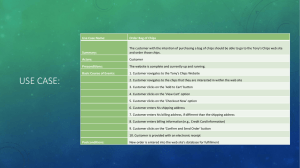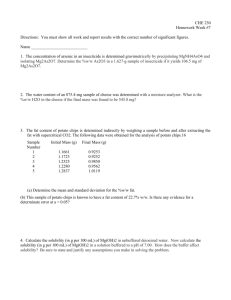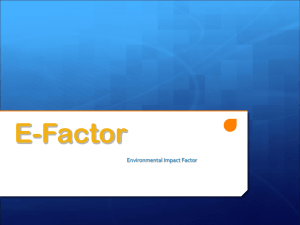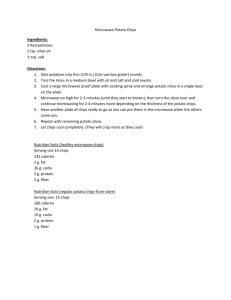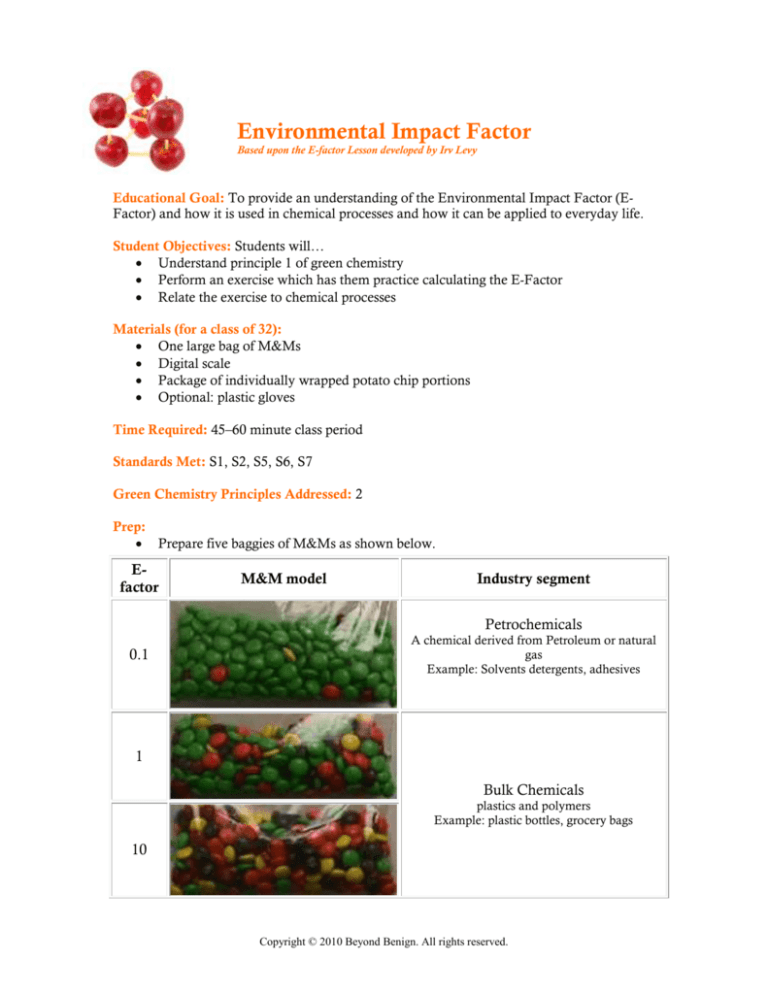
Environmental Impact Factor
Based upon the E-factor Lesson developed by Irv Levy
Educational Goal: To provide an understanding of the Environmental Impact Factor (EFactor) and how it is used in chemical processes and how it can be applied to everyday life.
Student Objectives: Students will…
Understand principle 1 of green chemistry
Perform an exercise which has them practice calculating the E-Factor
Relate the exercise to chemical processes
Materials (for a class of 32):
One large bag of M&Ms
Digital scale
Package of individually wrapped potato chip portions
Optional: plastic gloves
Time Required: 45–60 minute class period
Standards Met: S1, S2, S5, S6, S7
Green Chemistry Principles Addressed: 2
Prep:
Prepare five baggies of M&Ms as shown below.
Efactor
M&M model
Industry segment
Petrochemicals
0.1
A chemical derived from Petroleum or natural
gas
Example: Solvents detergents, adhesives
1
Bulk Chemicals
plastics and polymers
Example: plastic bottles, grocery bags
10
Copyright © 2010 Beyond Benign. All rights reserved.
Fine Chemicals
Chemicals used to make specific items
Example: coating on laptop screens, electronics
parts
100
Pharmaceuticals
250
Example: antibiotics, blood thinners
Procedure:
Project slide # 1
E-factor ≡ mass of waste ÷ mass of product
Ask the students for 4 volunteers who are ready for a snack.
Ask the volunteers to come to the front of the class.
Tell students that the goal of this experiment is to satisfy your need for a quick
snack and to test out our equation using these individually packaged potato
chips.
Ask the students to unpack the potato chips and make a pile of chips and a
pile of waste. You may want to have students use gloves at this stage so that
they can eat the chips after.
Ask the students to find the mass of the chips and then the mass of the
packaging and record the totals on the board.
Explain to the students that we are not finished yet as we haven’t used a key
component in green chemistry principle # 4 and tested to see if this product
retains it’s efficacy. Therefore the volunteers will need to eat the chips and tell
us if they satisfy their craving for a snack.
While they eat, have another student come up and solve the E-factor equation
for the potato chips.
Debrief with students as to how well the product performed in regards to it’s
e-factor. Make sure you include a discussion of why there was all that
packaging and how that is what the person designing the product decided you
needed in order to deliver the product you wanted.
Ask students how the e-factor of this product might be improved.
Ask students to get into groups of two or three.
Tell the students that actually this formula is used by green chemists to
evaluate chemical processes so at this point we would like to give you all a
bag of chemicals.
Hand out a small bag of M& Ms to each group of students.
Explain that this bag of M&Ms is very special but that unfortunately the only
ones that you can use are the green ones.
Ask students to separate the green M&Ms from the other colors and make
two piles. It turns out that green M& Ms have been discovered to be a key
Copyright © 2010 Beyond Benign. All rights reserved.
component in a revolutionary technology that helps to make hologram
images come out of cell phones so that people can see each other when they
chat.
The green part is actually the chemical that you need.
Ask students to calculate the e-factor for the bag of M&Ms
Ask the students to tell you whether they are OK with having all this waste in
order for them to have hologram images of their friends come out of their cell
phones.
Tell the students that you are going to give them another equation to help
them be creative.
Put the following equation on the board.
o E-factor = (mass of inputs - mass of outputs) ÷ mass of product
Ask students to creatively come up with ways that they could reduce the efactor.
Discuss with students their possibilities, real or imagined.
Show students the pre-prepared bags of M&Ms and explain how these bags
represent chemical processes.
Now tell the students that you know, they know that isn’t real but that these
techniques are really being used in industry.
Copyright © 2010 Beyond Benign. All rights reserved.

